10.5: Sedimentary Structures
- Page ID
- 5654
\( \newcommand{\vecs}[1]{\overset { \scriptstyle \rightharpoonup} {\mathbf{#1}} } \)
\( \newcommand{\vecd}[1]{\overset{-\!-\!\rightharpoonup}{\vphantom{a}\smash {#1}}} \)
\( \newcommand{\id}{\mathrm{id}}\) \( \newcommand{\Span}{\mathrm{span}}\)
( \newcommand{\kernel}{\mathrm{null}\,}\) \( \newcommand{\range}{\mathrm{range}\,}\)
\( \newcommand{\RealPart}{\mathrm{Re}}\) \( \newcommand{\ImaginaryPart}{\mathrm{Im}}\)
\( \newcommand{\Argument}{\mathrm{Arg}}\) \( \newcommand{\norm}[1]{\| #1 \|}\)
\( \newcommand{\inner}[2]{\langle #1, #2 \rangle}\)
\( \newcommand{\Span}{\mathrm{span}}\)
\( \newcommand{\id}{\mathrm{id}}\)
\( \newcommand{\Span}{\mathrm{span}}\)
\( \newcommand{\kernel}{\mathrm{null}\,}\)
\( \newcommand{\range}{\mathrm{range}\,}\)
\( \newcommand{\RealPart}{\mathrm{Re}}\)
\( \newcommand{\ImaginaryPart}{\mathrm{Im}}\)
\( \newcommand{\Argument}{\mathrm{Arg}}\)
\( \newcommand{\norm}[1]{\| #1 \|}\)
\( \newcommand{\inner}[2]{\langle #1, #2 \rangle}\)
\( \newcommand{\Span}{\mathrm{span}}\) \( \newcommand{\AA}{\unicode[.8,0]{x212B}}\)
\( \newcommand{\vectorA}[1]{\vec{#1}} % arrow\)
\( \newcommand{\vectorAt}[1]{\vec{\text{#1}}} % arrow\)
\( \newcommand{\vectorB}[1]{\overset { \scriptstyle \rightharpoonup} {\mathbf{#1}} } \)
\( \newcommand{\vectorC}[1]{\textbf{#1}} \)
\( \newcommand{\vectorD}[1]{\overrightarrow{#1}} \)
\( \newcommand{\vectorDt}[1]{\overrightarrow{\text{#1}}} \)
\( \newcommand{\vectE}[1]{\overset{-\!-\!\rightharpoonup}{\vphantom{a}\smash{\mathbf {#1}}}} \)
\( \newcommand{\vecs}[1]{\overset { \scriptstyle \rightharpoonup} {\mathbf{#1}} } \)
\( \newcommand{\vecd}[1]{\overset{-\!-\!\rightharpoonup}{\vphantom{a}\smash {#1}}} \)
\(\newcommand{\avec}{\mathbf a}\) \(\newcommand{\bvec}{\mathbf b}\) \(\newcommand{\cvec}{\mathbf c}\) \(\newcommand{\dvec}{\mathbf d}\) \(\newcommand{\dtil}{\widetilde{\mathbf d}}\) \(\newcommand{\evec}{\mathbf e}\) \(\newcommand{\fvec}{\mathbf f}\) \(\newcommand{\nvec}{\mathbf n}\) \(\newcommand{\pvec}{\mathbf p}\) \(\newcommand{\qvec}{\mathbf q}\) \(\newcommand{\svec}{\mathbf s}\) \(\newcommand{\tvec}{\mathbf t}\) \(\newcommand{\uvec}{\mathbf u}\) \(\newcommand{\vvec}{\mathbf v}\) \(\newcommand{\wvec}{\mathbf w}\) \(\newcommand{\xvec}{\mathbf x}\) \(\newcommand{\yvec}{\mathbf y}\) \(\newcommand{\zvec}{\mathbf z}\) \(\newcommand{\rvec}{\mathbf r}\) \(\newcommand{\mvec}{\mathbf m}\) \(\newcommand{\zerovec}{\mathbf 0}\) \(\newcommand{\onevec}{\mathbf 1}\) \(\newcommand{\real}{\mathbb R}\) \(\newcommand{\twovec}[2]{\left[\begin{array}{r}#1 \\ #2 \end{array}\right]}\) \(\newcommand{\ctwovec}[2]{\left[\begin{array}{c}#1 \\ #2 \end{array}\right]}\) \(\newcommand{\threevec}[3]{\left[\begin{array}{r}#1 \\ #2 \\ #3 \end{array}\right]}\) \(\newcommand{\cthreevec}[3]{\left[\begin{array}{c}#1 \\ #2 \\ #3 \end{array}\right]}\) \(\newcommand{\fourvec}[4]{\left[\begin{array}{r}#1 \\ #2 \\ #3 \\ #4 \end{array}\right]}\) \(\newcommand{\cfourvec}[4]{\left[\begin{array}{c}#1 \\ #2 \\ #3 \\ #4 \end{array}\right]}\) \(\newcommand{\fivevec}[5]{\left[\begin{array}{r}#1 \\ #2 \\ #3 \\ #4 \\ #5 \\ \end{array}\right]}\) \(\newcommand{\cfivevec}[5]{\left[\begin{array}{c}#1 \\ #2 \\ #3 \\ #4 \\ #5 \\ \end{array}\right]}\) \(\newcommand{\mattwo}[4]{\left[\begin{array}{rr}#1 \amp #2 \\ #3 \amp #4 \\ \end{array}\right]}\) \(\newcommand{\laspan}[1]{\text{Span}\{#1\}}\) \(\newcommand{\bcal}{\cal B}\) \(\newcommand{\ccal}{\cal C}\) \(\newcommand{\scal}{\cal S}\) \(\newcommand{\wcal}{\cal W}\) \(\newcommand{\ecal}{\cal E}\) \(\newcommand{\coords}[2]{\left\{#1\right\}_{#2}}\) \(\newcommand{\gray}[1]{\color{gray}{#1}}\) \(\newcommand{\lgray}[1]{\color{lightgray}{#1}}\) \(\newcommand{\rank}{\operatorname{rank}}\) \(\newcommand{\row}{\text{Row}}\) \(\newcommand{\col}{\text{Col}}\) \(\renewcommand{\row}{\text{Row}}\) \(\newcommand{\nul}{\text{Nul}}\) \(\newcommand{\var}{\text{Var}}\) \(\newcommand{\corr}{\text{corr}}\) \(\newcommand{\len}[1]{\left|#1\right|}\) \(\newcommand{\bbar}{\overline{\bvec}}\) \(\newcommand{\bhat}{\widehat{\bvec}}\) \(\newcommand{\bperp}{\bvec^\perp}\) \(\newcommand{\xhat}{\widehat{\xvec}}\) \(\newcommand{\vhat}{\widehat{\vvec}}\) \(\newcommand{\uhat}{\widehat{\uvec}}\) \(\newcommand{\what}{\widehat{\wvec}}\) \(\newcommand{\Sighat}{\widehat{\Sigma}}\) \(\newcommand{\lt}{<}\) \(\newcommand{\gt}{>}\) \(\newcommand{\amp}{&}\) \(\definecolor{fillinmathshade}{gray}{0.9}\)Overview
Sedimentary rocks often show distinctive patterns that are unrelated to their type of rock, yet reflect events or conditions during deposition and are called sedimentary structures. These patterns in the rocks can be very informative to geologists attempting to reconstruct the environment in which a sedimentary rock was formed. Imagine the wind blowing steadily along a beach; this wind pushes the sand into dunes that can be preserved in the rock record, informing us about the strength and direction of the wind along with the rock type.
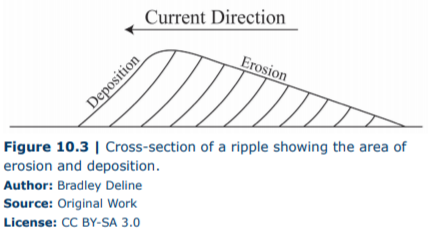
Examples of sedimentary structures are given in Table 10.2, but let us discuss them in more detail. The sedimentary structures that most students are familiar with are ripples and dunes. We are familiar with seeing dunes at the beach or in deserts or smaller ripples in mud puddles. In each case, these ripples are formed from either wind or water current. Ripples form by the current pushing sediment into a pile. On the down-current side, the sediment is shadowed and protected from the wind or water current. This means that there is erosion on the up-current side making a shallow slope and deposition on the steeper, down-current side. Therefore, if you cut a ripple in half and look at it in prospect you can see inclined layers of sediment building up on the steep down current side of the ripple. We can often see multiple layers of beds consisting of these inclined layers, which represent multiple generations of migrating ripples or dunes that are called cross-beds. Both ripples and cross-beds can indicate the presence and direction of the current in an environment.
| Table 10.2 | |||
| Sedimentary Structure | Description | Require Conditions | Figure |
| Ripple Marks | Either symmetrical or asymmetrical ripples present on bedding surfaces. | Water or air currents. Asymmetrical ripples indicate unidirectional currents with the steep slope facing down current and the shallow slope facing up the current. Symmetrical ripples indicate bidirectional currents. | 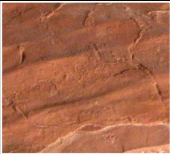 |
| Cross-bedding | Layers of inclined beds often altering directions from bed to bed. | Water or air currents | 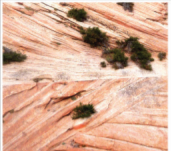 |
| Graded Beds | Beds of sedimentary rocks with a change in sediment size through the layer with smaller grains at the top of the bed and larger grains on the bottom | A turbulent water current carrying sediment loses energy and slows. | 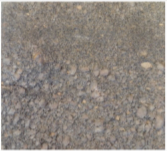 |
| Raindrop Impressions | Small indentations on a bedding plane from the impact of raindrops |
Soft muddy substrate that is exposed and subsequently buried with sediment |
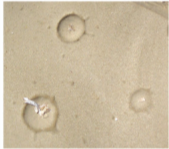 |
| Mudcrack Casts | Muddy cast infills of a polygonal pattern of cracks formed in mud as it drys. | Altering wet and dry conditions create cracks in mud which are then buried by sediment and preserved. | 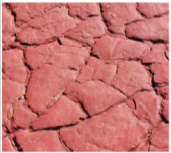 |
| Trace Fossils | Tracks, burrows, or other traces left by the activity of plants or animals. | The presence of plants or animals. These traces occur where the organism lives and more specific information can be obtained based on the identity of the tracemaker. |  |
We can also see structures that indicate changes in the strength of a current. Imagine a fast-moving, current-carrying a variety of sediment sizes. If the current slows, it will no longer be able to carry the largest particles and they will be deposited first. Then as the current continues to slow progressively smaller particles are deposited on top of the bigger particles, forming a sedimentary deposit called a graded bed. This graded bed is a sedimentary layer with larger clasts on the bottom and smaller clasts on the top. These types of beds can be the result of floods in a river or storms in the ocean. We can also observe features that are pretty self-explanatory such as casts of mud cracks (covered and preserved cracks that are the result of the drying of wet mud), and raindrop impressions (covered and preserved impacts of raindrops in soft mud). In both of these cases, the sedimentary structure tells us about the sediment, the water content, and its exposure at the surface above water level.
Related to sedimentary structures are trace fossils, which are patterns in the rocks that are caused by the activity of organisms. These can occur in many different ways and can indicate many different aspects of the environment depending on the trace and the identity of the tracemaker. Traces can be terrestrial such as footprints, burrows or dens, or the traces of roots, which can inform us about the climate, ecosystem, and the development of soils. Traces can also be found in freshwater and marine environments, such as burrows, borings, footprints, or feeding traces, which tell us about the sediment, chemistry of the poor water, and the life that lived within it.


